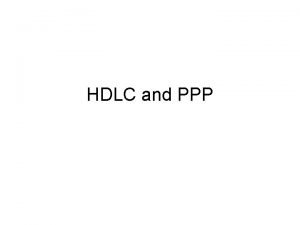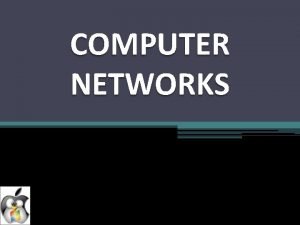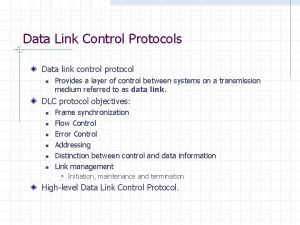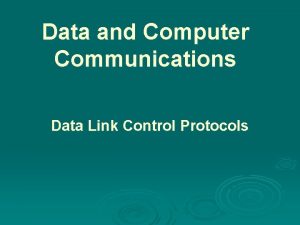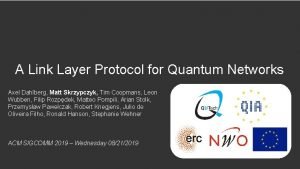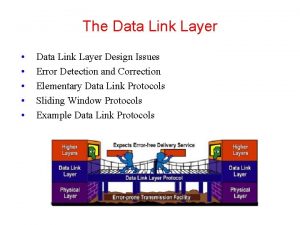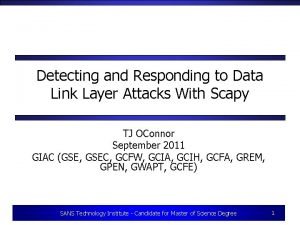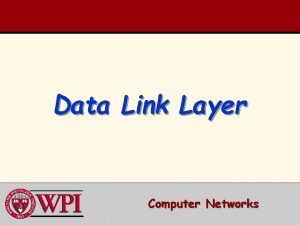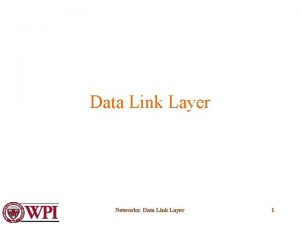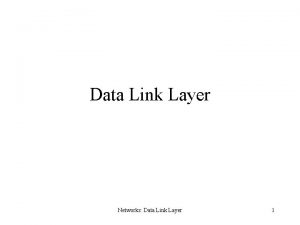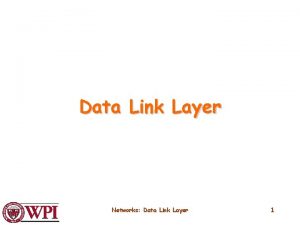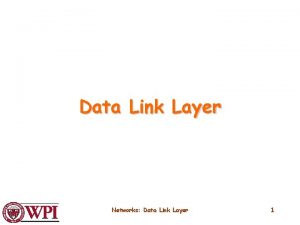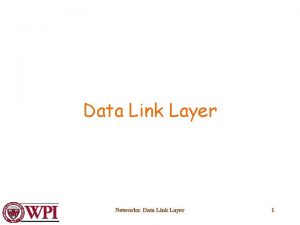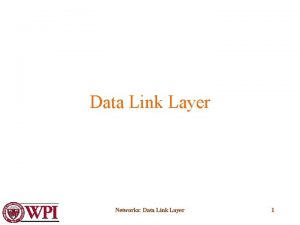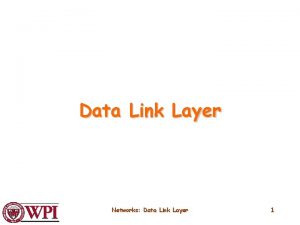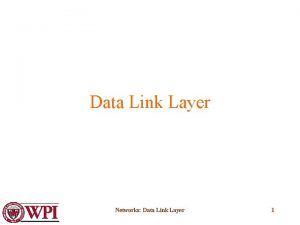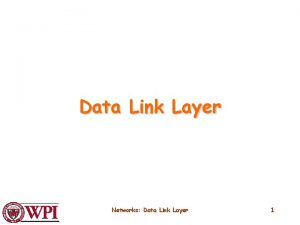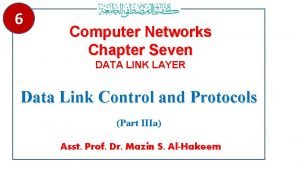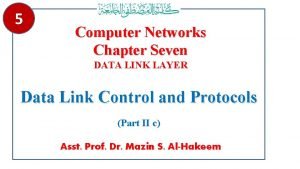7 Computer Networks Chapter Seven DATA LINK LAYER














- Slides: 14

7 Computer Networks Chapter Seven DATA LINK LAYER Data Link Control and Protocols (Part IIIa) Asst. Prof. Dr. Mazin S. Al-Hakeem

High-Level Data Link Control HLDC General Protocol Point-to-Point Access Protocol (PPP) : Dedicated Link Multiple-Access Protocol : Common Link (Broadcast Link) s e p y T s e m a r F I-frames S-frames U-frames Point-to-Poi nt Access Pr otocol (PPP) Multiple-Ac cess Protoco l Framing Transition Phases

7. 10 - Point-to-Point Protocol (PPP) Today, millions of Internet users who need to connect their home computers to the server of an Internet Service Provider (ISP) use PPP. The majority of these users have a traditional modem; they are connected to the Internet through a telephone line, which provides the services of the physical layer. But to control and manage the transfer of data, there is a need for a point-to-point protocol at the data link layer. PPP is by far the most common.

7. 10 - Point-to-Point Protocol Services PPP provides several services: (A) PPP defines the format of the frame to be exchanged between devices. (B) PPP defines how two devices can negotiate the establishment of the link and the exchange of data. (C) PPP defines how network layer data are encapsulated in the data link frame. (D) PPP defines how two devices can authenticate each other. (E) PPP provides multiple network layer services supporting a variety of network layer protocols. (F) PPP provides connections over multiple links. (G) PPP provides network address configuration. This is particularly useful when a home user needs a “temporary network address” to connect to the Internet.

7. 10 - Point-to-Point Protocol Missed Services On the other hand, to keep PPP simple, several services are missing: 1. PPP does not provide flow control. A sender can send several frames one after another with no concern about overwhelming the receiver. 2. 3. PPP has a very simple mechanism for error control. A CRC field is used to detect errors. If the frame is corrupted, it is silently discarded; the upper-layer protocol needs to take care of the problem. Lack of error control and sequence numbering may cause a packet to be received out of order. PPP does not provide a sophisticated addressing mechanism to handle frames in a multipoint configuration.

7. 10. 1 - Framing PPP is a byte-oriented protocol. Framing is done according to the discussion of byte oriented protocols at the previous chapter. Frame Format Flag: A PPP frame starts and ends with a 1 -byte flag with the bit pattern 01111110. Although this pattern is the same as that used in HDLC, there is a big difference. PPP is a byte-oriented protocol; HDLC is a bit-oriented protocol. The flag is treated as a byte. Address: The address field in this protocol is a constant value and set to 1111 (broadcast address). During negotiation, the two parties may agree to omit this byte.

7. 10. 1 - Framing PPP is a byte-oriented protocol. Framing is done according to the discussion of byte oriented protocols at the previous chapter. Frame Format Control: This field is set to the constant value 11000000. PPP does not provide any flow control. Error control is also limited to error detection. This means that this field is not needed at all, and again, the two parties can agree, during negotiation, to omit this byte. Protocol: The protocol field defines what is being carried in the data field: either 'user data or other information’. This field is by default 2 bytes long, but the two parties can agree to use only 1 byte.

7. 10. 1 - Framing PPP is a byte-oriented protocol. Framing is done according to the discussion of byte oriented protocols at the previous chapter. Frame Format Payload field: This field carries either the user data or other information. The data field is a sequence of bytes with the default of a maximum of 1500 bytes; but this can be changed during negotiation. The data field is byte stuffed if the flag byte pattern appears in this field. Because there is no field defining the size of the data field, padding is needed if the size is less than the maximum default value or the maximum negotiated value. FCS: The frame check sequence (FCS) is simply a 2 -byte or 4 -byte standard CRC.

7. 10. 2 - Transition Phases A PPP connection goes through phases which can be shown in a transition phase diagram PPP Transition Phases

Dead: In the dead phase the link is not being used. There is no active carrier (at the physical layer) and the line is quiet. Establish: When one of the nodes starts the communication, the connection goes into this phase. In this phase, options are negotiated between the two parties. If the negotiation is successful, the system goes to the authentication phase (if authentication is required) or directly to the networking phase. The link control protocol packets, discussed shortly, are used for this purpose. Several packets may be exchanged here. Authenticate: The authentication phase is optional; the two nodes may decide, during the establishment phase, not to skip this phase. However, if they decide to proceed with authentication, they send several authentication packets, discussed later. If the result is successful, the connection goes to the networking phase; otherwise, it goes to the termination phase. Network: In the network phase, negotiation for the network layer protocols takes place. PPP specifies that two nodes establish a network layer agreement before data at the network layer can be exchanged. The reason is that PPP supports multiple protocols at the network layer. If a node is running multiple protocols simultaneously at the network layer, the receiving node needs to know which protocol will receive the data.

Open: In the open phase, data transfer takes place. When a connection reaches this phase, the exchange of data packets can be started. The connection remains in this phase until one of the endpoints wants to terminate the connection. Terminate: In the termination phase the connection is terminated. Several packets are exchanged between the two ends for house cleaning and closing the link.

Point-to-Point Protocol (PPP) format of the frame two devices can negotiate data are encapsulated authenticate each other supporting a variety protocols connections over multiple links network address configuration not provide flow control very simple mechanism for error control not provide a sophisticated addressing mechanism

Point-to-Point Protocol (PPP)

Computer Networks Chapter Seven DATA LINK LAYER Data Link Control and Protocols s k n a h T (Part III a) Asst. Prof. Dr. Mazin S. Al-Hakeem
 Data link layer switching
Data link layer switching Data link layer design issues
Data link layer design issues Data link control
Data link control Elementary data link protocols in computer networks
Elementary data link protocols in computer networks Data link control protocols in computer networks
Data link control protocols in computer networks Communication data link
Communication data link A link layer protocol for quantum networks
A link layer protocol for quantum networks A switch in a datagram network uses a
A switch in a datagram network uses a Backbone networks in computer networks
Backbone networks in computer networks Osi reference model ppt
Osi reference model ppt Network layer is concerned with
Network layer is concerned with Network layer design issues
Network layer design issues Data link layer design issues
Data link layer design issues Materi data link layer
Materi data link layer Karmetasploit
Karmetasploit


